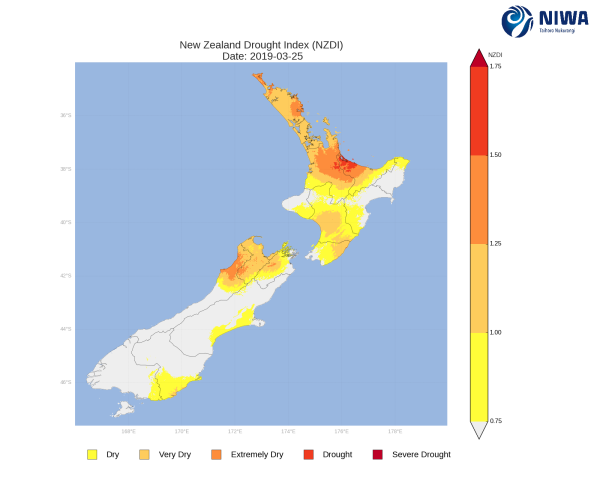A weekly update describing soil moisture across the country to help assess whether severely to extremely dry conditions are occurring or imminent. Regions experiencing these soil moisture deficits are deemed “hotspots”. Persistent hotspot regions have the potential to develop into drought.
Facts: Soil Moisture
Across the North Island, soil moisture levels generally decreased or remained constant during the past seven days. Notable decreases occurred in the Ruapehu and Taupo Districts, the Wellington Region, and the Gisborne Ranges. Conversely, soil moisture levels saw a slight improvement in parts of coastal Bay of Plenty and in northern Waikato, although the soil moisture levels still remain below average for this time of year. The driest soils across the North Island compared to normal for this time of the year are found in eastern Northland, northern Waikato, interior Bay of Plenty, and Tararua District. The wettest soils for this time of the year, albeit still slightly drier than normal, are located near Wellington City.
Hotspots continue to be found across a large part of Northland, Auckland, northern Waikato, and interior Bay of Plenty, as well as central Manawatu-Whanganui and Napier south to Wairarapa.
In the South Island, soil moisture levels generally increased in the west and decreased in the east during the past seven days. Notable increases were found along the west coast where an Atmospheric River brought heavy rain to the region on 25-27 March. The driest soils across the South Island compared to normal for this time of the year are found in lower Southland, while the wettest soils are found in coastal Fiordland and in the Queenstown-Lakes Region. South Island hotspots are currently located in a portion of interior Marlborough, eastern Banks Peninsula, south coastal Otago and parts of lower Southland.
Outlook and Soil Moisture
In the North Island, passing showers are expected mainly in eastern and northern areas through Sunday (31 March). A front may bring moderate to heavy rain to big parts of the island on Monday (1 April) with rain totals over 30 mm possible mainly in the higher terrain. Drier air will move in behind the front on Tuesday, but showers can linger in eastern areas.
Rain totals across the North Island are forecast to be above average for this time of year, and soil moisture levels should improve nearly everywhere over the next seven days, shrinking or eliminating the current hotspots.
In the South Island, mostly tranquil weather is anticipated through Saturday (30 March). However, an incoming front may bring moderate to heavy rain to the West Coast and northern regions on Sunday and Monday (31 March – 1 April). Rainfall totals exceeding 50 mm are possible in the higher terrain, while low level areas along the West Coast, Tasman and Marlborough may see rainfall totals around 25-30 mm. The east coast will be shielded from most of the rain, but showers are possible in the interior. Drier air will move in behind the front on Tuesday.
With the anticipated rainfall in the next seven days, soil moisture levels are expected to increase in the north, remain near constant in the west and decrease in the east. The current hotspots in interior Marlborough, coastal Otago and parts of lower Southland will likely be shrinking.


Pictured above: Soil Moisture Anomaly Maps, relative to this time of year. The maps show soil moisture anomaly for the past two weeks.
Background:
Hotspot Watch a weekly advisory service for New Zealand media. It provides soil moisture and precipitation measurements around the country to help assess whether extremely dry conditions are imminent.
Soil moisture deficit: the amount of water needed to bring the soil moisture content back to field capacity, which is the maximum amount of water the soil can hold.
Soil moisture anomaly: the difference between the historical normal soil moisture deficit (or surplus) for a given time of year and actual soil moisture deficits.
Definitions: “Extremely” and “severely” dry soils are based on a combination of the current soil moisture status and the difference from normal soil moisture see soil moisture maps.
Hotspot: A hotspot is declared if soils are "severely drier than normal" which occurs when Soil Moisture Deficit (SMD) is less than -110 mm AND the Soil Moisture Anomaly is less than -20 mm.

